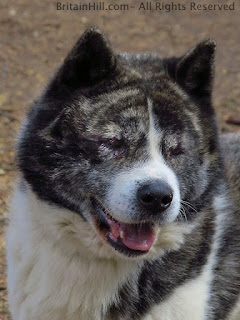Finally we have some public graphs for Akitas in MyDogDNA! Here is link for that.
As you can see, we still need much more tested dogs to get graphs working better. But you can see some important things even from this information.
Most of the tested Akitas are from different lines and there is some blends tested also. All are quite close to each other genetically, even the blends. But the blends have bigger individual heterozygosity than pure Akitas. My Lemmy boy have 26,1% heterozygosity when median for Akitas is 20,6% (this is the situation at 3.11.2013). So he have the biggest diversity in tested Akitas at the moment. Our grand old man Raj have 21,6% heterozygosity, what is better than the median in the breed. That is quite well considering that his 10. generation COI is 8,6%. He might be also the oldest of tested dogs, so this can explain his amount of heterozygosity. Generation after generation the amount of inbreeding will rise in closed populations, so naturally the older generations tend to have wider genepool. Or he can just be lucky and get different genes from his parents! We are still waiting Paavo's results, so I can't say anything about her.
Genetic relationships graph is not working very well at the moment. I asked about it from Genoscoper (the company who offers MDD test) and they explained to me that the graphs are hard to read for now and we need more tested dogs to make the graph more clear. At the moment Lemmy is quite close to some AKIHO lined dogs, what is kinda hilarious.
This is just a fast note, school is keeping me very busy but I try to write more analysis from the MDD information in the future. If you are interested about the MDD test, please check out this page http://www.mydogdna.com/
As you can see, we still need much more tested dogs to get graphs working better. But you can see some important things even from this information.
Most of the tested Akitas are from different lines and there is some blends tested also. All are quite close to each other genetically, even the blends. But the blends have bigger individual heterozygosity than pure Akitas. My Lemmy boy have 26,1% heterozygosity when median for Akitas is 20,6% (this is the situation at 3.11.2013). So he have the biggest diversity in tested Akitas at the moment. Our grand old man Raj have 21,6% heterozygosity, what is better than the median in the breed. That is quite well considering that his 10. generation COI is 8,6%. He might be also the oldest of tested dogs, so this can explain his amount of heterozygosity. Generation after generation the amount of inbreeding will rise in closed populations, so naturally the older generations tend to have wider genepool. Or he can just be lucky and get different genes from his parents! We are still waiting Paavo's results, so I can't say anything about her.
Genetic relationships graph is not working very well at the moment. I asked about it from Genoscoper (the company who offers MDD test) and they explained to me that the graphs are hard to read for now and we need more tested dogs to make the graph more clear. At the moment Lemmy is quite close to some AKIHO lined dogs, what is kinda hilarious.
This is just a fast note, school is keeping me very busy but I try to write more analysis from the MDD information in the future. If you are interested about the MDD test, please check out this page http://www.mydogdna.com/
 |
| Lemmy's genetic diversity |
 |
| Raj's genetic diversity |







